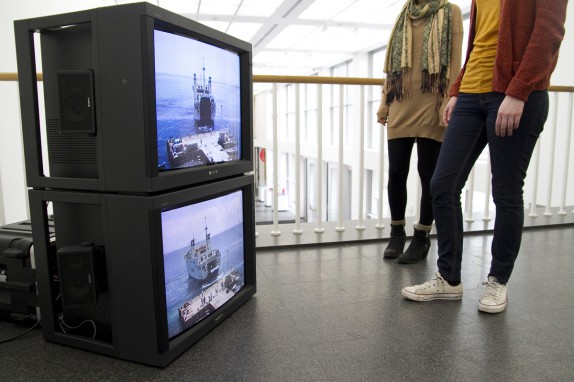Martin Creed:Work No. 405

The following reflection was published by the Museum of Contemporary Art, Chicago in July 2012.
Two box televisions, encased and stacked like shipping crates, rest unobtrusively in the corner of the MCA’s third-floor landing. Work No. 405: Ships Coming In by Martin Creed appears at first to be screening the same shot twice: a blank sea. The ocean on the upper television is a deeper blue with an enigmatic and seemingly sourceless wake that V’s across the frame. Aside from that wake, there is nothing curious about the scenario we are faced with. This is a picture of the sea. In fact, the whole sequence of events that are about to unfold will prove themselves unremarkable. Precisely for that reason, the detail and difference between loops, the resonant gestures, out of sync but parallel, become sympathetic inside the camera’s gaze.
In the midst of this wake, the first ship appears, crossing the screen from left to right, almost parallel with the pier’s end. Below and shortly after, a second ship enters the lower television. This one also crosses the screen, ever behind the ship above. The ship above has already begun to veer its nose out to the horizon—it moves farther out to sea—before straightening to face the pier directly and resume its approach toward us, the camera, and the body of land on which the camera stands. These simple back and forth maneuvers, reminiscent of parallel parking, occupy the majority of this work. They would be banal and quick, save for the physics of water and its relationship to the buoyant ferry. Under these slowed conditions, abstract angles between ship and pier become points of interest. They could be sketches, paintings, or haikus. They could be illustrations for scientific hypotheses. Surprisingly both ships attain the same goal at almost exactly the same time—the ferry arrives! Its paired and simultaneous representation points not only to the minute differences between efforts, but also the ritual, repetition, and practice of this route. This ferry has berthed countless times.
An audience gathers on the lower pier to see the ship come in, waiting no doubt to attain something inside the boat. A tottering, small dog, all business and independence, trots through those witnesses, just before a compact truck comes scooting out from the lower ferry’s hull, honking its horn like a bleating lamb—full of life. The truck is smaller than the palm of my hand. The ship on the top television is not so well attended. When the compact truck exits, long after its lower twin, it does not honk, nor seem half as satisfied. One cannot help but wonder the differences—are these different times of day? Different days of the week? Different seasons altogether? The rhythm of the ship remains constant, though its cargo may change. And then, suddenly: the ships disappear. First the lower boat, then, the upper: gone, like ghosts, as though they never were. Accompanying piers empty as well, bare as they were in the beginning. All that remains is the sea—a veneer of stability—and the light.